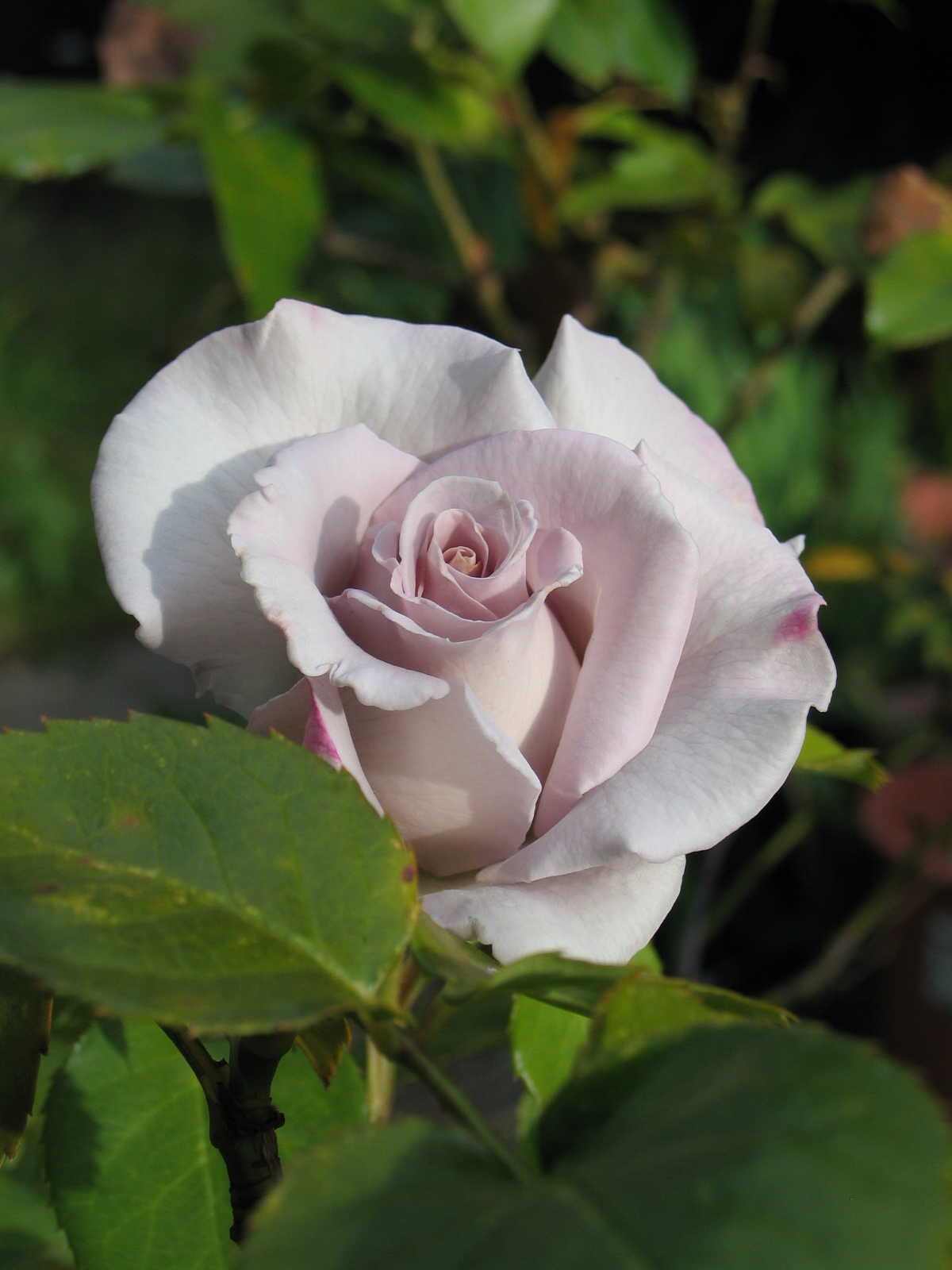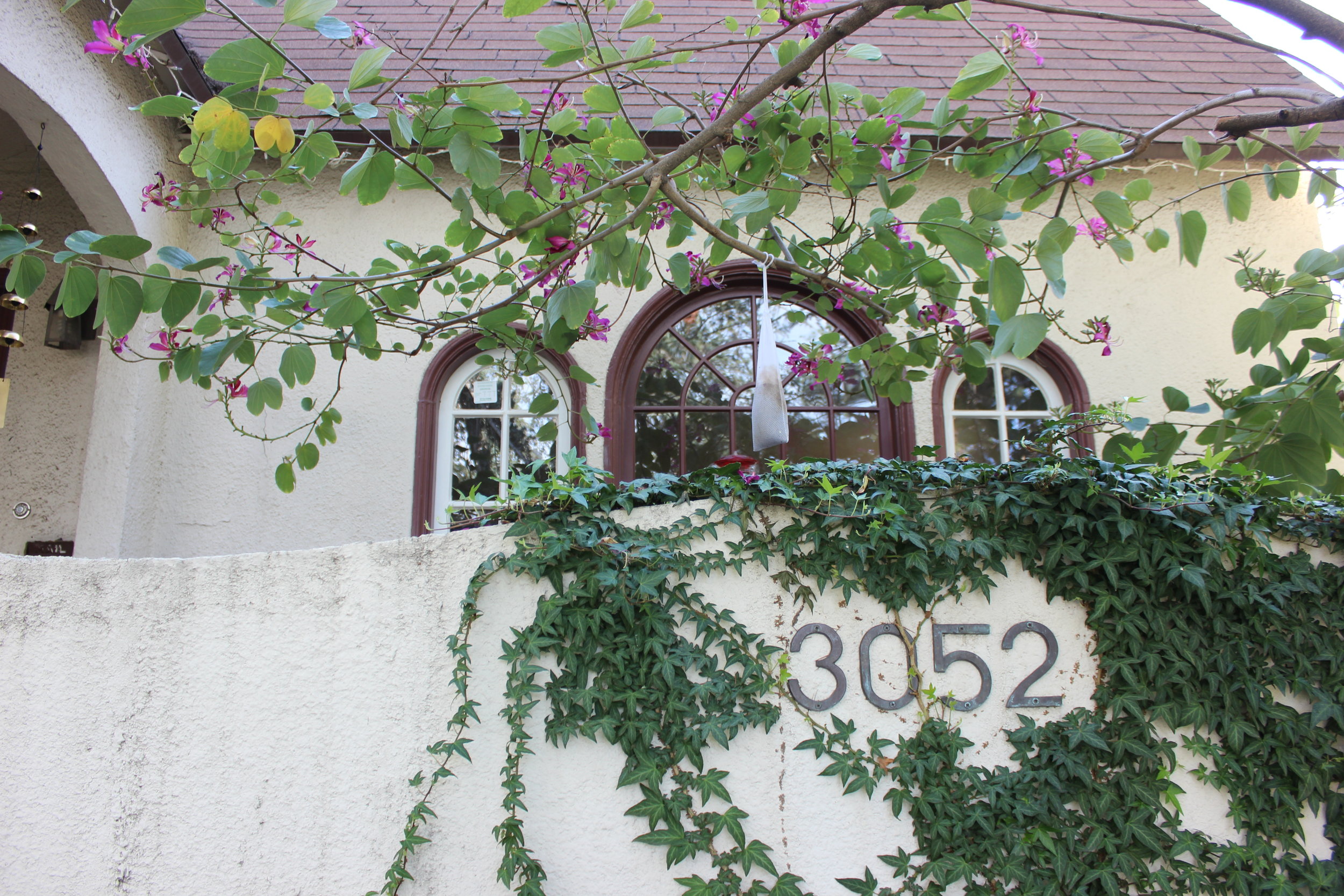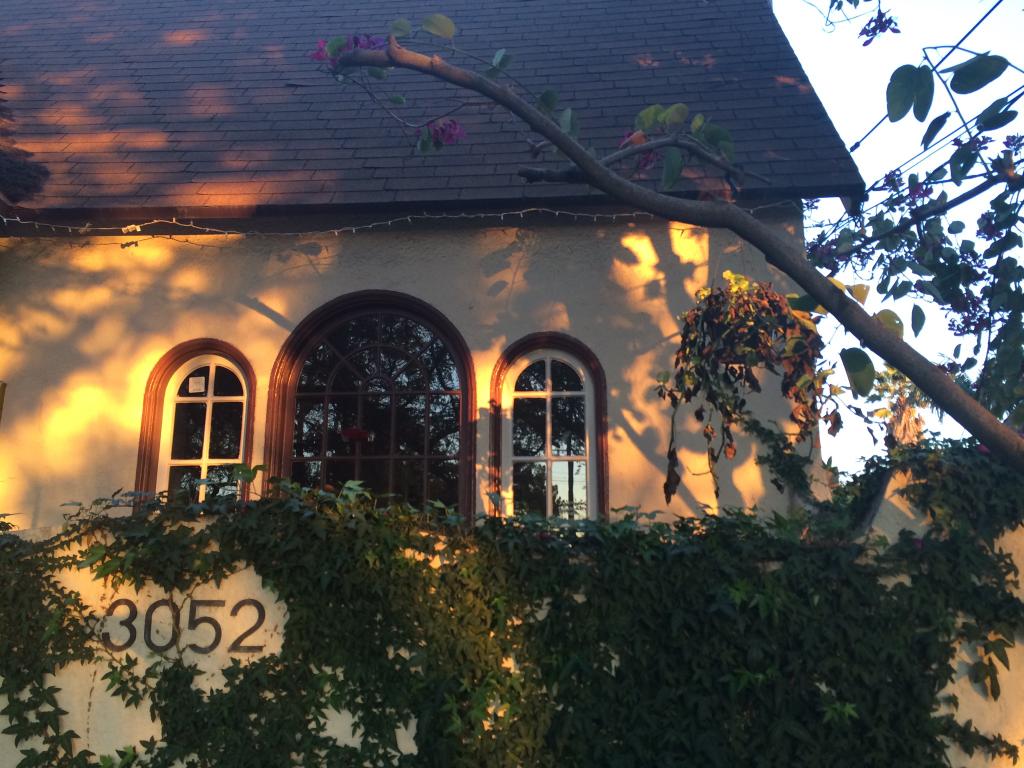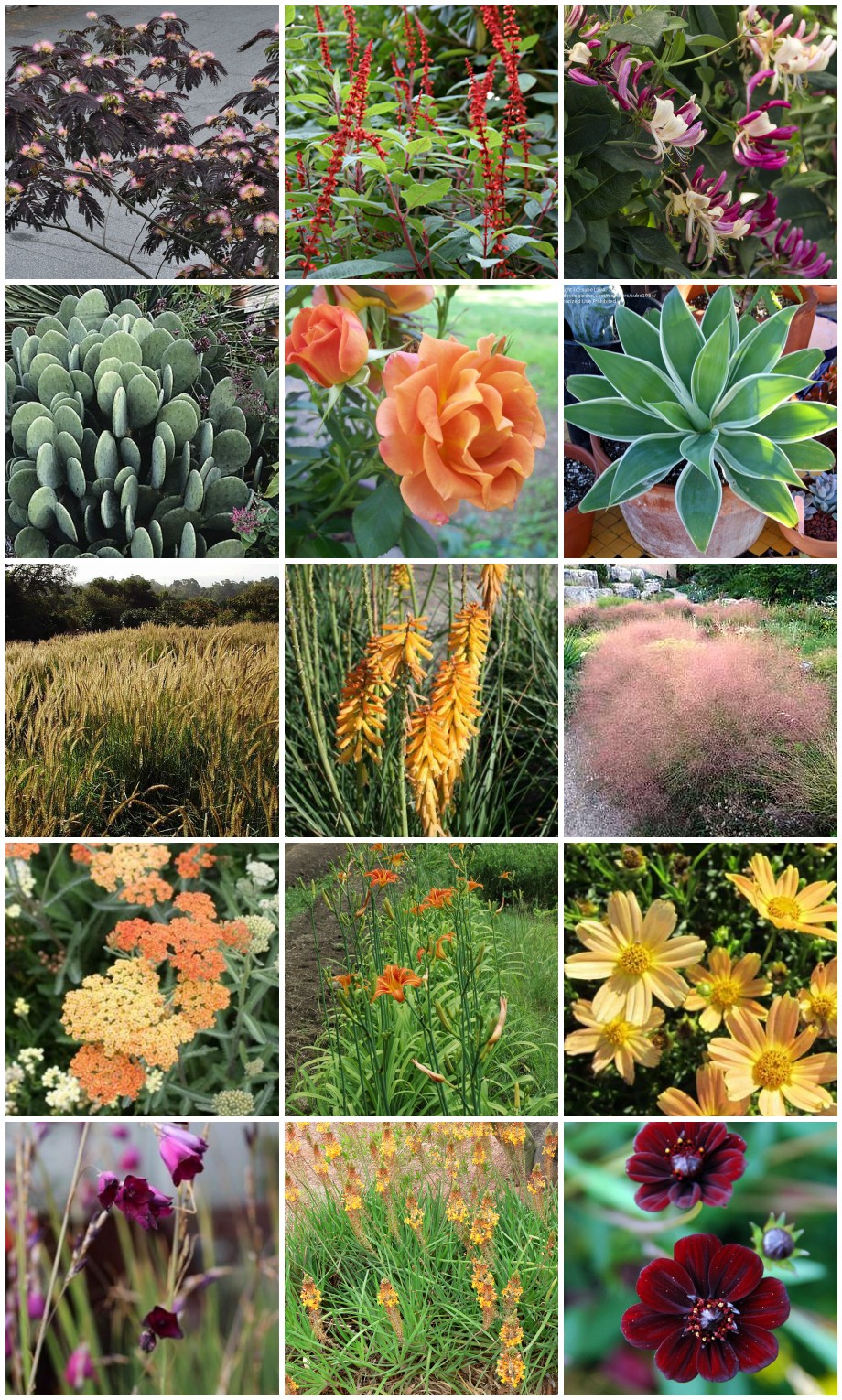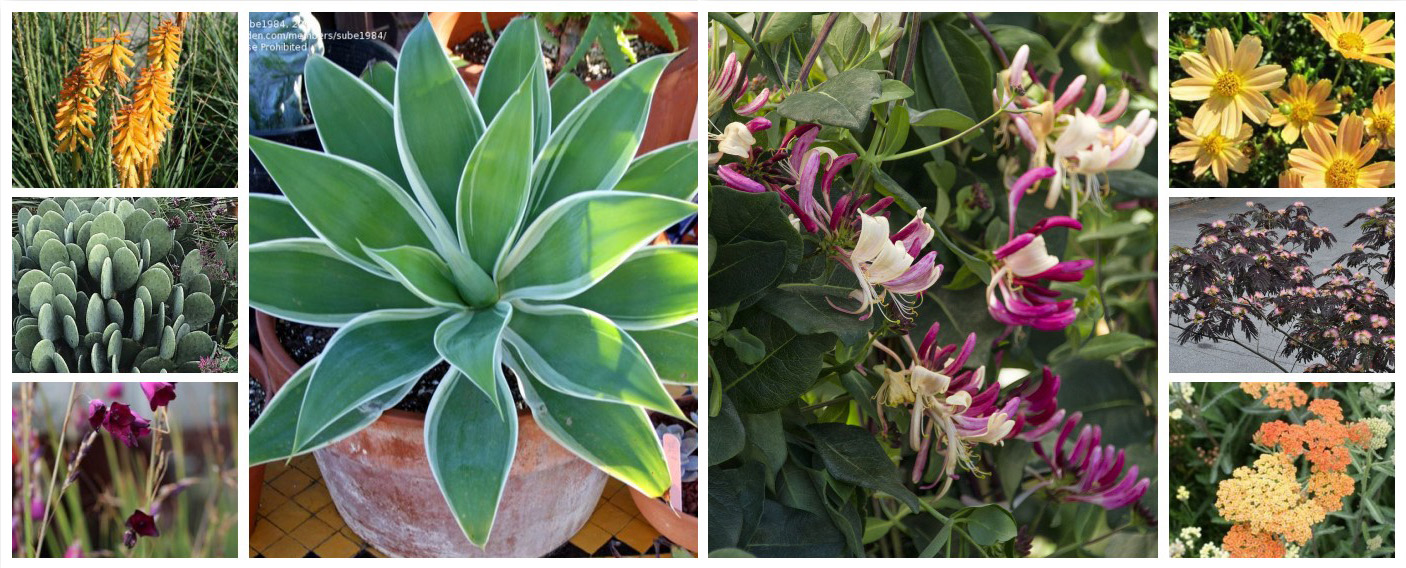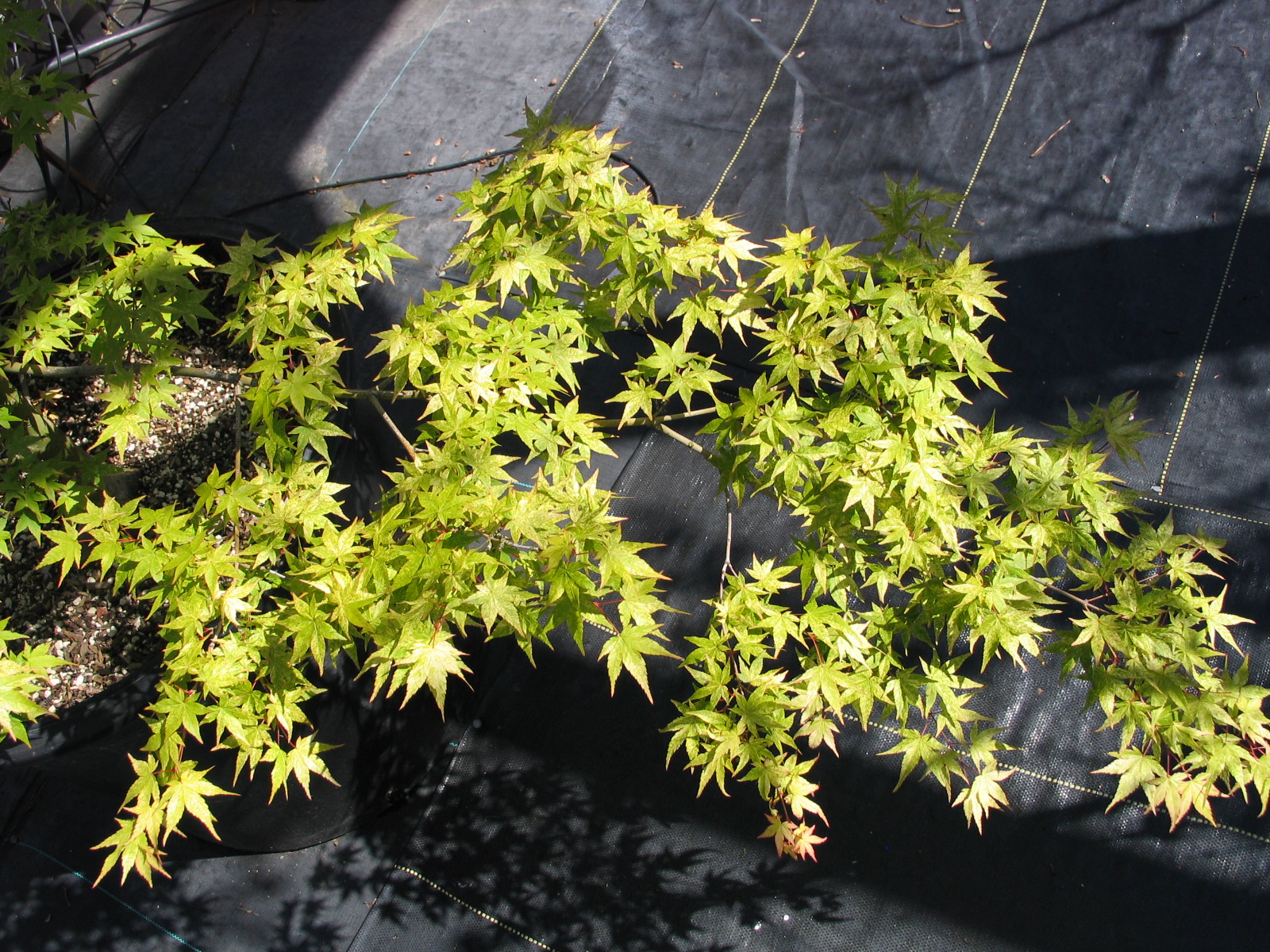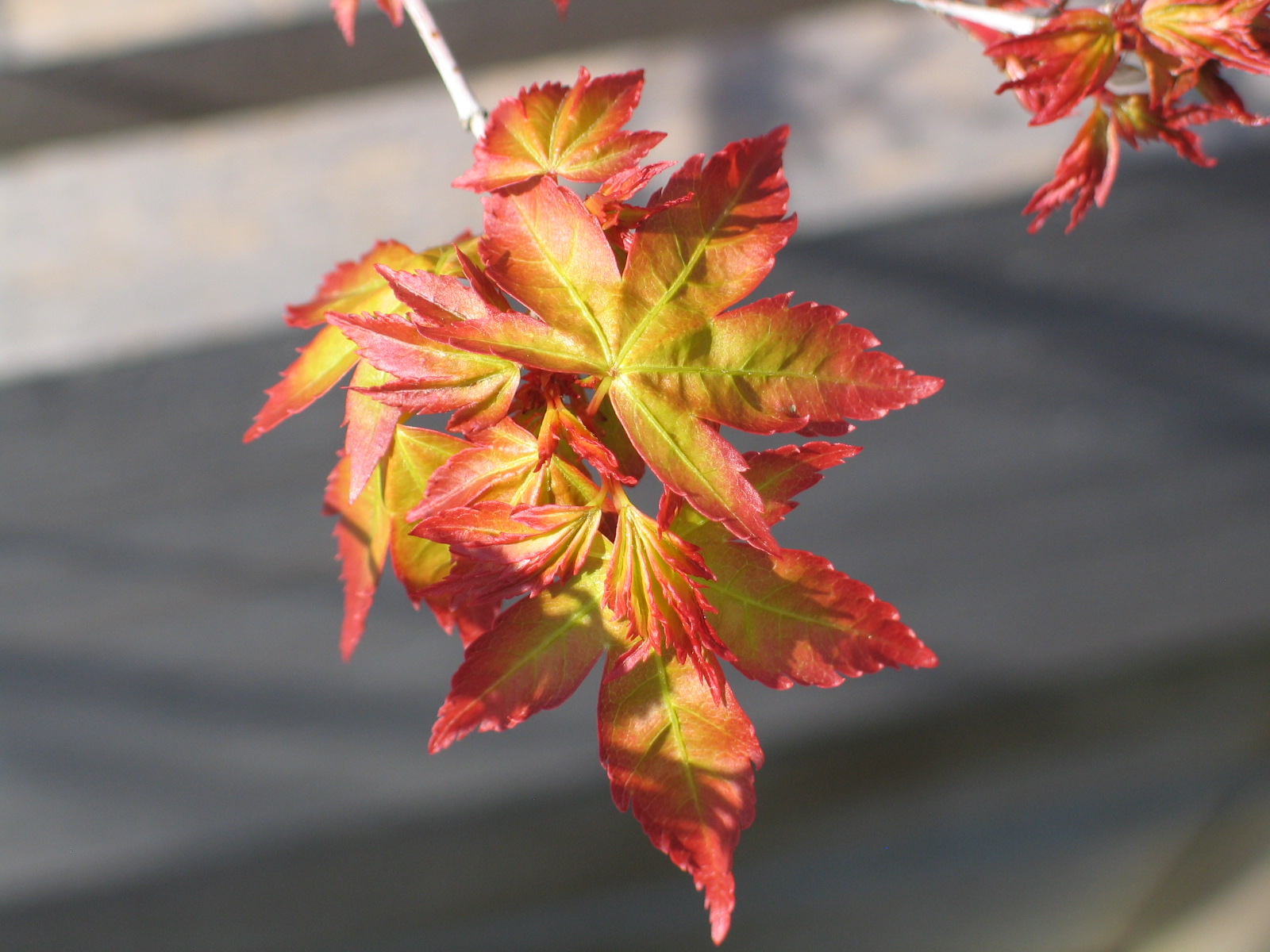You've heard that you should water trees deeply and infrequently, right? I take that approach a bit further and use it for everything - trees, perennials, roses, everything. I'm careful with my water anyway having grown up in Los Angeles during the 70's drought when we let our yellows mellow, removed or reduced lawns, and collected shower water.See, we're in for some serious growing pains while we struggle to understand and adjust to mandatory water restrictions now in 2015 - I don't need to repeat the advice, you already know it (ditch the lawn, add compost and mulch, etc). But what we need to be doing is more than just using less water, we need to use water more wisely - to help our plants fend for themselves better. I see water as a training tool and my plants as smart, but slow. They can't fetch and training them to do much of anything takes years.As of my last water bill, I'm down to 36 GPD (gallons per day) including landscaping. Before you bow in awe to this amazing feat, you should know that I irrigate my garden a little differently than most and I'm not watering anything I don't want to keep. Let the rest die, they're out of here anyway. Here's where I water differently: I bought a 15 gal. Magnolia 'Black Tulip' (that baby green tree in the background left-side). It is rated as having "moderate" water needs in Oakland by WUCOLS. Moderate isn't exactly water-wise, but I've got a theory..... and so far, so good. I planted the tree a year ago this month. At the same exact time, my client in Mill Valley had three planted (guess whose idea that was). Their landscape contractor did exactly what they usually do - they amended, fertilized, and watered the hell out of those trees. My client's trees bloomed and grew and leafed out beautifully, gained stature nicely. Mine didn't. Luckily for them, theirs are next to a lawn that I'm sure they'll keep as long as they can, where I have no lawn. Below is a better shot of mine last May (1 month after planting).I planted mine with a bit of compost, watered it in well that first day, and walked away. It looked fine for a while, then it got all stressed out and started dropping leaves. I watered it again, a nice soaking, and it threw out some new leaves. We did this all summer: I kept an eye on it, watering only when I found signs of stress in the leaves, but then not again until I saw more stress. It was nerve-wracking. The tree did not visibly thrive, and it sure as heck didn't get much bigger. I'm pretty sure it would slap me if it could.... but it survived. While it was dormant over winter and I held my breath to see how it would do come spring. This spring when it started blooming, I was delighted with how many (albeit smallish) flowers there were on my young tree, and now it is leafed-out for the season. I'll be doing the same this summer, soaking the presumably larger root-zone, but as seldom as possible. I'll also be adding more compost on top (not working it in, that's the worms' job) and maintaining a good layer of mulch over that.I believe that what I am doing will be better for my tree's long-term durability. I believe that I gave it reason to throw energy into its root system in search of water, and that I rewarded deep root growth instead of fast, exciting foliage and gains in stature. Over the winter, its root system likely continued to dive and while I watered, soaking further and further down but less and less often, we're working together to train this "moderate" water needs tree to survive more like a drought tolerant tree. Here it is today, not much bigger, but doing just fine:I don't water fast enough that it trickles off, doing by hand what irrigation designers call "cycle and soak", making sure that the water goes into the soil and nowhere else. I'm also taking advantage of the few light rains we had to water further than the rain itself went = deep watering every time.I can't tell others to do this, the tree looked like hell that first year of establishment and I think most people wouldn't watch closely enough nor would they enjoy the experience (even I was a bit nervous). We'll see how things go this summer, but I can tell you that I don't water much, maybe once a month? I avoid watering if it is overcast or cool outside. I look closely at my plants in the most stressful times - when it is blazing hot, sunny, and/or dry and windy. If I see stress, I'll water. If not, forget it. I'll keep you posted on how things go this summer.The most impressive thing, though, is what I noticed in putting together this post - look how much my roses LOVE this treatment - they get watered only when the tree gets watered and I have yet to see them look even a little stressed. You can see the change best between the second photo and the one above. They're the hybrid tea 'Stainless Steel' (my favorite). Here's the original one (now on the right in the photo above) blooming in my old garden in Alameda in 2010 and again in 2012:
BAD GARDENER!
I've been keeping busy in what feels like a perfect storm of absolutely inexcusable (insert many cuss words) BAD "gardening". I don't know what the heck happened, but the stars aligned and I've been doing nothing but evaluating problems, recommending that gardeners get fired, and interviewing new gardeners. I have three current projects dealing with this at the same time, and today a project I haven't even started working on yet became the fourth.This morning's text from my new client brought such sad news. She had the most charming Hong Kong Orchid (Bauhinia blakeana) tree and came home from work to find that it was absolutely butchered by the "gardeners". They were not directed to prune the tree, and I have to tell you - this has happened to more than one client where someone has butchered a tree without approval or permission! My client loves this tree and I'm working on finding someone to help us in directing its recovery from the abuse.Below you'll see the few photos I have of the tree - I was so charmed by it, I can't figure out why I didn't get better photos.It used to overhang the front patio that the living room looks out on - is focused on - but now I'm told that you can't even see the tree from inside anymore. If you are sensitive to gorey pictures, now is the time to avert your eyes:I warned you, don't say I didn't.SO - what the hell? Thing is, any idiot can call him/herself a gardener. There's no training required, and most people are happy enough to have someone else do the mowing that they don't worry about it - how hard can it be? But what many don't think about until it is too late is that those specimen plants can be responsible for a good up-tick in your property's valuation. New trees don't add value, but healthy, mature ones totally do!I will post again soon about some of the other issues with gardeners - but for now, may I just list these few things that every property owner should know:An Arborist is an educated, certified person who is held to certain standards of care and who can be reported for not upholding those standards. Hiring a tree service company does not mean an Arborist will be involved in your project, nor does it mean you'll get qualified advice. If you have an important tree, make sure you protect it with advice and evaluations from someone qualified to give them.A Consulting Arborist can help you diagnose problems or evaluate a tree, the American Society of Consulting Arborists has a great web page that lets you search for one near you: ASCA. They aren't the folks with the clippers, but they can tell you if a tree is in good health and stuff like that.There is no specific qualification for someone to do pruning. However, some arborists do work in hands-on ways or work for companies that do. To find these kinds of people, check out the International Society of Arboriculture, or ISA. The difference being arboriCULTURE as opposed to arborIST.The moral of this story is that everyone who hires or works with a gardener or a landscape maintenance company should have the conversation about doing unauthorized work. This is a huge no-no, and I'd like to make a law about it, but until that happens, we've got to look out for the trees ourselves. Well, us and the Lorax anyway.
San Gabriel Garden's Preliminary Planting Palettes
Back here, I talked about the conceptual design process, where I developed and sent over design concepts with a memo full of notes to the Owners. I sent all this via email because they live in Southern California and I live in Northern California, about a 6 hour drive away, so in-person meetings aren't always feasible. I also know the Owners pretty well - the husband is an Architect I have worked with, and the wife has a background in Interior Design - so I trusted that they'd be able to read the memo alongside the concepts and make an informed selection of their favorite. They did exactly that, sending me back comments on their preferred designs and I will now start to draft the designs for use in preparing construction drawings (so hang tight...)The next thing to do is develop the Schematic Design. In Schematic Design, I will make sure that the Conceptual Design evolves to have elements represented at actual size while I strive to hold true to the concept and incorporate their comments. For example, I will make sure that any paths are an appropriate width, furnishings are represented at their real measurements, gates, paving patterns, fencing, materials, etc will begin to be discussed, but I won't change the overall intent. I'll try to remember to share that when it is accomplished.... for now, one of the elements that needs discussion is a planting palette. In every phase of design, I imagine the feel of the place, and few things have more impact on that than the plants!What I'm trying to get at here is that in addition to designing for plants that will thrive in the same sun exposure, watering practices, soil type, climate zone, etc there's an importance to gathering plants that want to be seen together. The plants bring more than just leaves and color, they bring personality (and seasonality!) to the place. The plants and the concepts (at least for me, others may work differently) are not separate discussions, but both part of a larger vision. For this project, I made a huge list of plants I thought would work in San Gabriel as well as plants I thought the Owners would like. I imagined the designs as real spaces, re-imagining them repeatedly with different planting palettes until I had edited the lists down into a concept for the planting palette.Now, this does not represent the layout of the planting palette, and any plant geek can see that I've got some hydrozoning to do (putting low water use plants together and irrigating separately from higher water needing plants). That will happen in future phases, but for now, I am playing with a planting palette as a preliminary concept. For the rear garden, I chose lots of green foliage plants with what I equated to a "Hollywood / tropical" palette with many plants that could also grow in Texas (the Owners are from Texas, which is where I know them from). I did the same exercise for the front, but without the Hollywood / tropical aspect to it. Don't ask me why, that's just the direction it went.The front garden and the rear garden for this project are imagined with different vibes, but that doesn't mean that we can't use some of the same plants in both and we should! Having the two be completely distinct runs the risk of making their property seem disjointed. Take a look at the preliminary palette for the front garden (above) in contrast with the preliminary palette for the rear (below):They seem very different at first, but both have the same Honeysuckle vine in common and the same Agave. Each of the little square photos shows each plant at the same size, and of course we also aren't demonstrating how much of each plant there will be, nor giving a complete idea of their forms.... their impact in real life based only on visual impact could look much more like this for the front:and like this for the rear:See how they relate but take the same impact plants in different design directions? isn't that trippy?! I'll repeat this exercise with materials and furnishings, and the hope is that the whole mess will come together and become more than the sum of its parts.Years ago, when I worked on a pro-bono project with this Owner and had a conversation where he explained to me that the building he had designed had to be white. It wouldn't be the same building if it was not white (I was vehemently against it being white, I thought it was unsympathetic to the landscape). We had what must have been an amusing and fervent "discussion" for any flies on any nearby walls, and in the end, he convinced me. The color was not just a tacked-on thing at the end, it was integral to the spirit of his design. What I'm describing here is that lesson brought forward in my career and applied to my own work. In designing the outdoor environment and making connections to indoor spaces and people, one shrub does not always do the same job as another, and plants are not so interchangeable as one might hope. So stay tuned for the results - between me and the Owners, their home, and the process of refining the design, the end result is always a little bit of a surprise. I will be excited to see how the process progresses with them, and then to see it installed?! holy heck, I can't wait.
Design beginning with a PEN?!
My folks visited me about six months ago or so. While reading my draft portfolio booklet, dad started laughing. He'd read where I stated that I start every design with a pen. 'No you don't, you have a drawing tablet! You draw in the computer!' says my dad. No, I don't, but I thought it was a funny assumption and so here we are talking about it.Here's the thing - using technology is lovely when you know what you want it to do, but when you have no idea, when you're imagining stuff, using Photoshop with a tablet and stylus is not the most direct route from the brain. You have to push buttons, set layers, import files, etc. Forget THAT! For me, using a pen is the shortest distance between creative thought and seeing it with your eyes (on the page).Take for example a current design project in Southern California, it is for the residence of an Architect I worked with years ago:I typically sit in a coffee shop and doodle for a while while studying site photos to really wrap my head around the issues of the site and try out various ways of shaping the space, fitting in uses, etc. I use a printed base plan under tracing paper, my favorite Japanese ballpoint pens, and a latte (in reverse order). The first round is not to scale, exploring idea after idea, small about the size of an index card.Sometimes I do studies that try to fit certain ideas to the site regardless of anything, and these usually look pretty nuts, especially when I don't re-draw the parts I've decided against:After generating several concepts, I refine a few ideas into what I still call conceptual design, and I limit myself to 3-4 per area max. In this case, there's a front garden and a rear garden. Even now, nothing is really measured, it is all eyeballed and still very sketchy. Notes around the edges help me remember the images I had in my mind's eye for plants and other materials. I have to make some assumptions about the clients' lifestyle, and sometimes I suggest things they have not thought of - like what if they said they want the rear garden to be for kids' play but the front is actually a better size for it....(like in this garden).... the interview process can provide a lot of information, but you really can't explore all the possibilities in an interview or two, and it helps to see ideas drawn when discussing them.At this point, I sometimes send it to the client for input. Below are the finalists for the front garden:and here (below) are the finalists for the rear garden:Some clients enjoy working at this sketchy loose level, and this client is definitely one of them. I'm honored to be designing the home landscape for his family, I hold his abilities in the architecture world in high regard and I know he and his wife have great taste. However, there are clients for whom it is more appropriate to narrow things down to one or two ideas and do a much more formal, complete presentation. I like both approaches, but for sure, this one allows for the client to have much more input at the very early stages.SO - which will they choose? We'll see.
Test, don't guess
I have a handful of stories from professional practice where soil or plant pathology testing should have been performed but wasn't. I personally believe that soil should always be tested before any fertilizer or amendment is added, and follow-up testing should be done every couple of years to see how the soil health has changed. Not testing soil or sick plants before spraying or amending the soil is like prescribing medication without knowing what disease you are treating. You wouldn't do that to your body, so why do we do this to our biggest investments (your home or commercial property) ?!Thankfully, getting lab tests done is not difficult if you take the few minutes needed to do it right. Most soil and plant pathology labs are easy to work with, they'll tell you what to do and how to send it in, and will provide you with a report explaining their findings. Bammo - diagnosis! Proper treatment! Hooray!Now for my cautionary tale:Years ago I was working for a firm in San Francisco and we had a client with a mature beloved Japanese Maple. It had a nice shape, and was reportedly absolutely beautiful in the fall. Their project involved building an underground garage underneath this tree which required that we dig the tree out, box it, crane it off-site, and have it cared for while the garden was re-made in a new design on the roof deck of this garage. The tree would be the centerpiece for the new design, and I thought how lovely that they were willing to spend tens of thousands of dollars to have it salvaged and brought back when a new tree would be so much cheaper.Before we started demolition, the client called and said that the tree wasn't as leafy (this was mid-summer) as it had been the year before. We called a couple of arborists out to the site who took a good look at it, tested the trunk with a densiometer, and decided that it needed a little more water - we had just gotten through a few unusually warm weeks, so we all thought no big deal. The gardener was asked to provide it with some nice deep watering and we waited to see how it would respond. It repaid us with a flush of tender new leaves and we delighted in this result.I wish I could remember how this next step was decided on - we asked the gardener to fertilize it. The gardener was a well-meaning fella who had done a good job so far. His English was not great, but nobody had a problem with that. He fertilized the tree and within a week, WHOOMP! Naked tree. It dropped every single leaf. We could not understand why - it was just recovering! We finally sorted out that the gardener had mis-understood the label on the fertilizer package and used 10x the recommended amount! That tree was sitting in a toxic wasteland of salts and chemicals. Rather than wait for his next visit, I was dispatched to put soaker hoses around it and try to water the fertilizer out of the soil. I left those soaker hoses on for hours, they were coiled around and around under the entire dripline of the tree. We had the gardener follow-up, soaking the soil thoroughly on his next couple of visits, and we hoped that the excess fertilizer had been literally washed away.You can imagine how glad we were when it repaid us with a second flush of new leaves.... only there was something different.... these leaves were smaller, slower, not quite right. Nobody knew what to do; we just kept watch and hoped for the best. About a week later, it was dead. Dead-dead. All those new leaves fell off and you could feel that it had passed all the way on.This was such a disappointment for the Owners and for us - after-all, here we were, a team of arborists, landscape architects, and the well-meaning gardener. It sure looked like we killed it. This is when we did the first intelligent thing: we had the tree and the soil tested. We took samples of the leaves, the branches, some root clippings, and the soil, and sent it all off for analysis. Care to guess what we learned?That poor tree had a raging infection of some kind of pathogen with a long name I've long since forgotten, and the lab said that this infection had likely been there for a couple of years already to be this bad. The tree was doomed from the start; our screwups just pushed it over the edge. In a way, this nightmare saved the Owners a bunch of money, but that didn't make anyone feel any better. We'd spent so many billable hours trying to figure it out, they ended up wasting a lot of time and money paying us to professionally accidentally kill their beloved tree.So you know, the lab that we used was Soil and Plant Lab. They are my favorite lab because their people are helpful and knowledgeable and their reports are thorough and easy to understand. It isn't so expensive to do, and one test can save not only your money, but your peace of mind and the health of your investment.BTW, I took the photos at Momiji Nursery in Santa Rosa back in 2006 when I was working on this project. They sell beautiful Japanese Maples.Thank you for reading, as always, I look forward to your comments!J
Italian Garden in the fall
I was just sent two new photos of my project in Italy (mentioned before HERE) now that it is fall. The garden looks fantastic, which is a real testament to the Owners taking such wonderful care of it! That is such an important aspect of any garden's success, and I'm delighted to share these images with you:
Marketing (or not) With My Clients' Homes
I think I did it right. I started designing gardens before I knew that was what I would "grow up" to do. My first forays into site design as a kid included a fantasy plant nursery, pet store, and flower shop. My parents' back yard was the subject of many site plans as well, though they didn't implement my thoughts.I earned my BLA (Bachelors of Landscape Architecture, a 5 year degree), got my first "real" job, and after a few years, began taking my own projects on the side. This year I started teaching and finally went full-time as my own boss. I have essentially spent all my free time for the last mumble-mumble years absorbed in design, gardens, plants, and everything related.You would think that I would have no shortage of beautiful built projects to share online, adding new ones all the time. Below is part of why I don't put a full body of work in public online places:Naturally, many of the projects I've worked on have been with former employers. Many of them are my work or at least partly so, but the former employer owns the intellectual property. I can put the work I did in my own portfolio, that is industry standard, but it is not kosher to put that stuff on my own website or blog to promote myself apart from promoting the company I worked for at the time. In addition to that, I have agreements with some former employers that state I won't put anything online that came from my employment with them, and some clients and I have similar agreements. Not marketing with clients' projects can be limiting in this age where everything is available at a click, but there ya go.I respect the wishes of my clients and some of them are more particular about their privacy than others. I never post or put online anything that a client would like to keep private. For some of them, that is everything. The work I do is often someone's home, and I totally get wanting to keep home private!Additionally, a garden is never done. The design work is only a portion of making a quality outdoor environment. A great many projects are phased in for budget reasons or other limitations (this can take years!), and it also takes time for the plants to grow in. In a recent post on a project in Italy, you can see that the photos I posted span about 2 years - after two years, that garden is just getting to the point where it looks good enough to take photos and post them. If I had posted it too early, it would not have had the same ability to represent what the intention was in the first place.I am incredibly fortunate to work on amazing projects with amazing people - whether their own home, a rental, or a commercial or institutional project, there's opportunity for discovery, beauty, and environmental benefits all around.... so am I still doing it right? I sure hope so.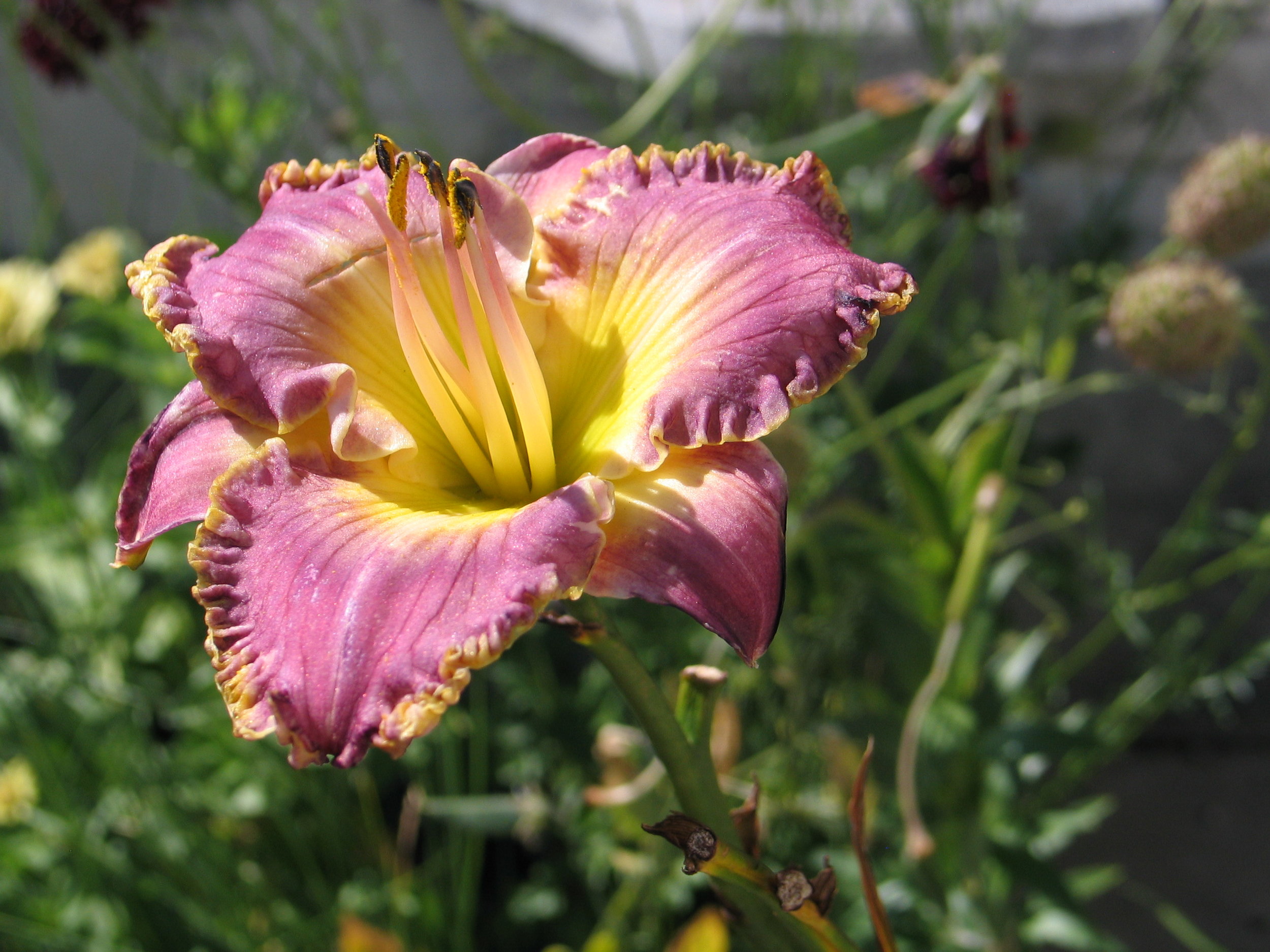
A Garden in Italy
2014 June
While I was away neglecting my modern web-presence-building duties, I enjoyed working on a particularly wonderful little project.... a Bed and Breakfast in Italy! I have never been to Italy, but when my good friend and talented architect Glenda Flaim showed me her work on Casa Incantata, I asked if I could take a stab at the planting design which had yet to be finalized. Neither of us had any idea what would happen. Come on, what do I know about plants in Italy?! Niente. The way we worked around that, and got the garden done was a genuinely collaborative effort involving Glenda, the Owners, their gardener, some dutch visitors, and me:First, Glenda sent me a photo of the site with notes (in green) on her thoughts for the planting:We chatted about the decisions on the photo - why the hedge, what is the lawn for, stuff like that. I studied snapshots of the building and tried to imagine what it would be like to be there in person. Glenda mentioned that the house had just won a national award for sustainable architecture, and was photographed soon after I started noodling with the design of the garden on paper. You can see pre-garden professional architectural photos here and here. She sent me a computer drafted file of the site and I gathered photos of plants that came to mind.I started the planting design in June 2012:I mapped out the planting design in areas with palettes. The areas got names: there was "lawn", "spicy", "meadow", and "hedge". I wrote a description of how each of these areas would be different from each other, what forms and colors I was trying to emphasize, and what colors I wanted to avoid entirely. I wrote out how these plants would change with the seasons and the desired effects. With lists of plants and their written intentions, the memos were translated into Italian and back into English through Glenda.The Owners and their gardener started looking for the plants and sent word back what was available and not, and we figured out plants that might work instead. More memos handling spacing and layout were translated back and forth, plant research was done on both continents. Plants were purchased and installed as they were found; this took a few seasons to finish. Some were purchased in Italy, some shipped from the U.S., and the last, elusive bulb was a gift from some visitors from Holland who learned of the missing bulb in discussions of the garden during their stay.Over the last 2 years, I've gotten a couple of photos a season so I could see how the garden was doing. They had wasted no time getting plants in the ground. Later that same year (fall 2012), the lawn (Hernaria glabra) which also extended between the pavers, was getting its start:By the following Spring (2013) it had filled-in very nicely!The other plants were coming along too:By that Summer, you could see the different zones expressing themselves:And just last month, I got another update:It is challenging to know how a garden will look when you're designing it, and there were many anxious moments when I knew they were investing in my advice and I could only hope that the Owners would like the results. I'm not sure it is possible to tell if the image in my head matches what the garden will become. I can't know ahead of time if the Owners will like what the garden will become, and yet it is dependent on them and everyone who takes care of it to continue to support the design's intention as the garden is maintained.I am finally able to share (two years later) how things are going here in this post. I can also share that the owners are very happy with their garden, and conveyed to me this sentiment:
Il giardino che ho sempre sognato!!!
(The garden I have always dreamed about!!!)
I couldn't have asked for more.
My Client's Plants
I am working on the design of a garden in San Francisco and was pleasantly surprised today by the delivery of the Hellebores that were ordered from Canada. While I was potting them for protection during their wait to be installed at the site, it occurred to me that this shipment of plants represented some thoughts on customer service and the design/construction processes.Most Landscape Architecture firms would not be able to accept delivery of plants for a client and care for those plants until they could be installed. They might rely instead on either using only the plants that are seasonally available or contract growing (with someone else) to care for those plants that must be received before the site is ready. There are issues of liability (what if they die?!), space, and materials for the task. What results can be either a prohibitively complicated and expensive ordeal, a garden that is skewed to one particular season, or having to ask the client to be patient and wait while plants become available in the future (not always acceptable by some clients). 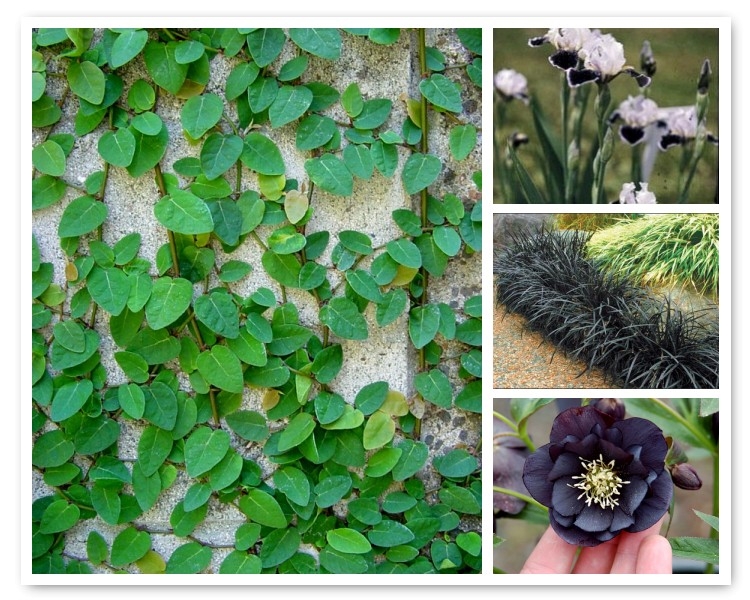 Included in this particular project there will be a discrete courtyard featuring a statue. We are using four different plants; Ficus pumila (Creeping Fig), Ophiopogon nigrescens (Black Mondograss), Helleborous 'Onyx Odyssea' (a double black flowering Lenten Rose), and Iris 'Frosted Velvet' (a "miniature tall" form Bearded Iris). The Ficus and Ophiopogon are evergreen and will form the main planting to show off the sculpture, then the Iris will be in bloom in the Spring with leaves from late Winter through Summer, and the Hellebores will be in bloom in Winter with leaves holding on through Spring. I don't expect to have both Irises and Hellebores flower at the same time, though it is possible that this could occur depending on weather conditions and temperatures (especially in the Bay Area). While the Irises prefer more sun and the Hellebores more shade, the site location and orientation make it possible to use both in the same small area.I presented the palette (above) to the client earlier this month. Before doing presenting, I learned that the Iris were not going to be shipped until next July, and that our local growers who carried the Hellebores had already sold out for the year. I explained to the client that we would be ordering the Iris for delivery nine months in the future and that the Hellebores would need to be ordered immediately from Canada before the grower's shipping season closed. He accepted the planting concept, so I had the plants ordered with delivery to my home. I did this for a couple of reasons:1. I wanted to inspect the plants before anyone else saw them to make sure there were no problems (and I work from home). Having them shipped to my home also meant that I could accept delivery at any time (they arrived today - the Saturday after Thanksgiving) regardless of holidays, weekends, and business hours.2. The plants would be shipped bare root and would need immediate attention by someone who knew what to do and had the time.3. The landscape contractor had not yet been formally retained.4. This also made me feel that I was giving my client the best service I could by personally protecting his investment in them and, by extension, his trust in me.It is my habit to order plants from all over the world. Because of this, I knew ahead of time that both mail order companies were reputable and that the plants would likely be in great shape. I was not disappointed! Fraser's Thimble Farms worked with me to hold the plants until the payment arrived. I took their advice to pay for air priority shipping. The plants also required a Phytosanitary Certificate (they were inspected by the Canadian Food Inspection Agency) before coming into the U.S. The shipment was also opened and inspected by U.S. Customs upon arrival.Below are some photos from this morning's potting:
Included in this particular project there will be a discrete courtyard featuring a statue. We are using four different plants; Ficus pumila (Creeping Fig), Ophiopogon nigrescens (Black Mondograss), Helleborous 'Onyx Odyssea' (a double black flowering Lenten Rose), and Iris 'Frosted Velvet' (a "miniature tall" form Bearded Iris). The Ficus and Ophiopogon are evergreen and will form the main planting to show off the sculpture, then the Iris will be in bloom in the Spring with leaves from late Winter through Summer, and the Hellebores will be in bloom in Winter with leaves holding on through Spring. I don't expect to have both Irises and Hellebores flower at the same time, though it is possible that this could occur depending on weather conditions and temperatures (especially in the Bay Area). While the Irises prefer more sun and the Hellebores more shade, the site location and orientation make it possible to use both in the same small area.I presented the palette (above) to the client earlier this month. Before doing presenting, I learned that the Iris were not going to be shipped until next July, and that our local growers who carried the Hellebores had already sold out for the year. I explained to the client that we would be ordering the Iris for delivery nine months in the future and that the Hellebores would need to be ordered immediately from Canada before the grower's shipping season closed. He accepted the planting concept, so I had the plants ordered with delivery to my home. I did this for a couple of reasons:1. I wanted to inspect the plants before anyone else saw them to make sure there were no problems (and I work from home). Having them shipped to my home also meant that I could accept delivery at any time (they arrived today - the Saturday after Thanksgiving) regardless of holidays, weekends, and business hours.2. The plants would be shipped bare root and would need immediate attention by someone who knew what to do and had the time.3. The landscape contractor had not yet been formally retained.4. This also made me feel that I was giving my client the best service I could by personally protecting his investment in them and, by extension, his trust in me.It is my habit to order plants from all over the world. Because of this, I knew ahead of time that both mail order companies were reputable and that the plants would likely be in great shape. I was not disappointed! Fraser's Thimble Farms worked with me to hold the plants until the payment arrived. I took their advice to pay for air priority shipping. The plants also required a Phytosanitary Certificate (they were inspected by the Canadian Food Inspection Agency) before coming into the U.S. The shipment was also opened and inspected by U.S. Customs upon arrival.Below are some photos from this morning's potting:
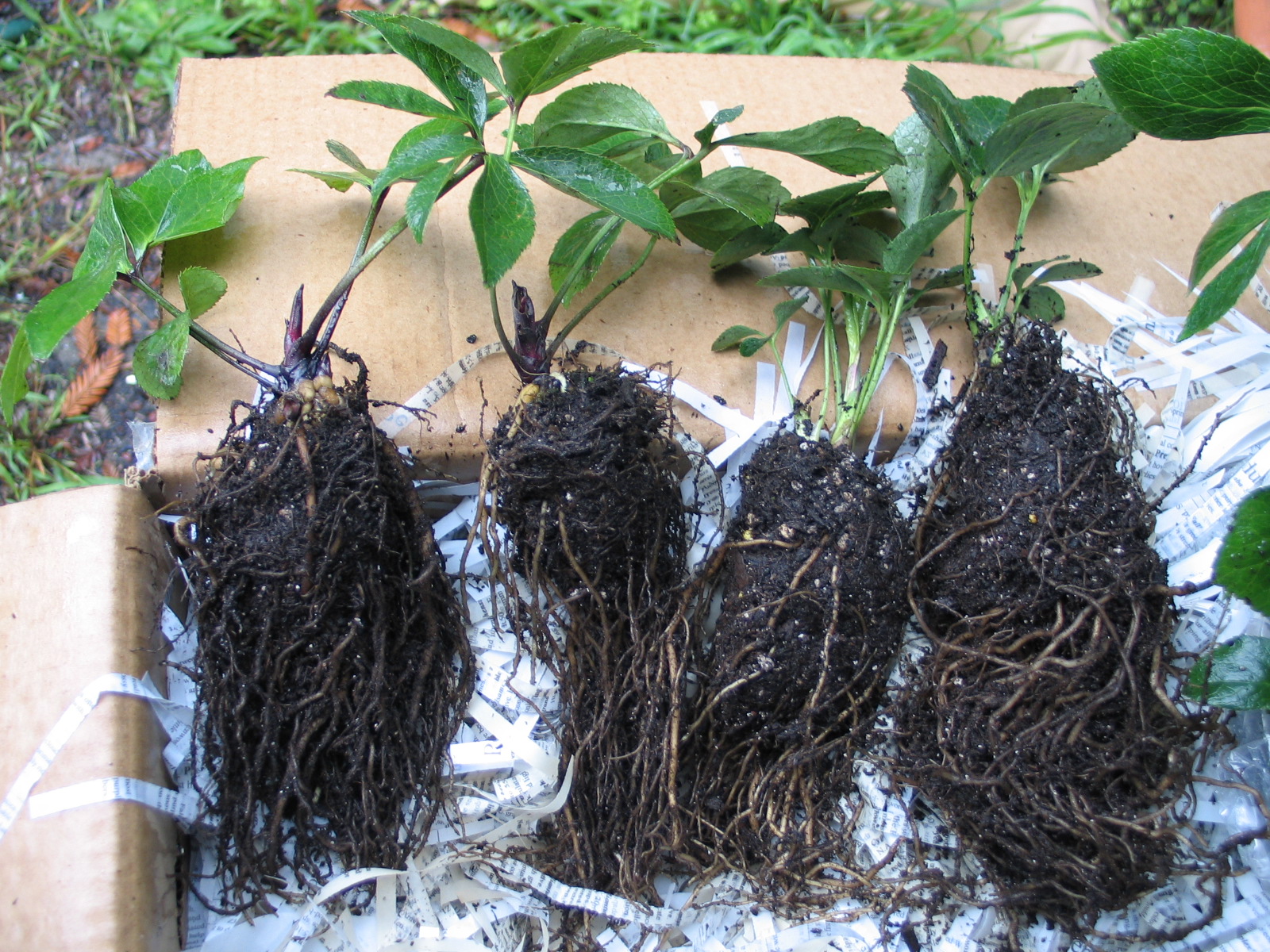
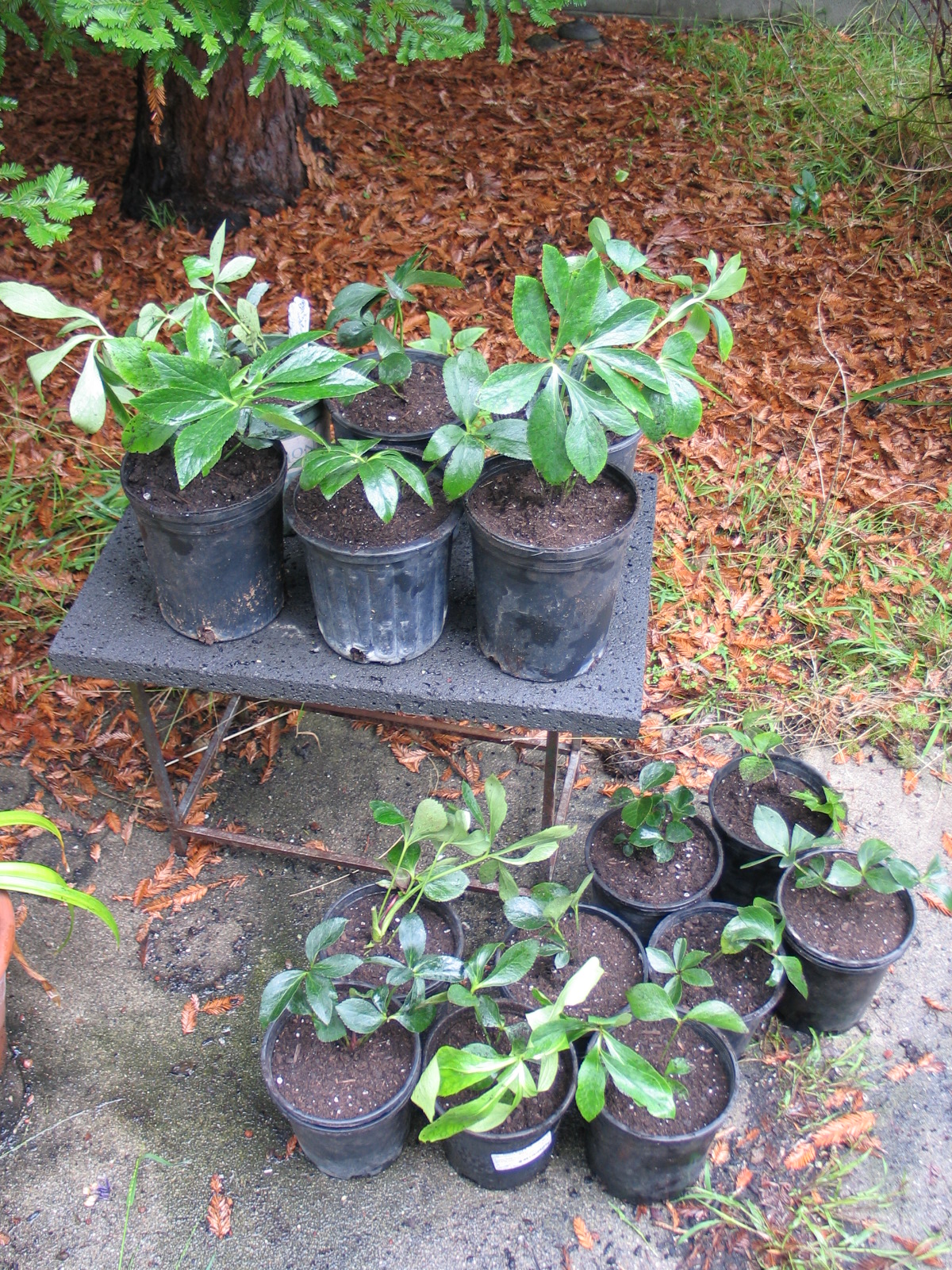 All in all, excellent plants - potted and ready for what comes next. My own Hellebores have not leafed-out yet, so it will be interesting to see how these behave, but they each have new growth on them (see the middle photo). They've been through a lot, being bare-rooted, inspected twice, then finally re-potted (they'll be disturbed again soon when they're planted in their new home).I have been frustrated in the past with the issues that come up when trying to design a garden around the seasonal availability of the plants I want to use. I think it is well worth the extra effort to get the exact plants desired rather than giving up and just finding something else that is less of a pain. I am looking forward to seeing them planted in their new home and will post again....
All in all, excellent plants - potted and ready for what comes next. My own Hellebores have not leafed-out yet, so it will be interesting to see how these behave, but they each have new growth on them (see the middle photo). They've been through a lot, being bare-rooted, inspected twice, then finally re-potted (they'll be disturbed again soon when they're planted in their new home).I have been frustrated in the past with the issues that come up when trying to design a garden around the seasonal availability of the plants I want to use. I think it is well worth the extra effort to get the exact plants desired rather than giving up and just finding something else that is less of a pain. I am looking forward to seeing them planted in their new home and will post again....
I am honored. Thanks!
My friend and colleague Page Huyette asked me to write a post for her blog as a guest writer. I wrote about editing as part of the design process. Everyone works differently, I think this post illuminates part of my process really well (it should, I wrote it!).Here is the link to that post, and below one of the images (because no blog post should be without pictures!). I took this snapshot one day a few years ago. I had been working for a while and when I "came up for air", I thought that all the stuff on my desk (at Scott Lewis Landscape Architecture) looked interesting together. I'm glad I took the picture, I had no idea it would come in handy some day.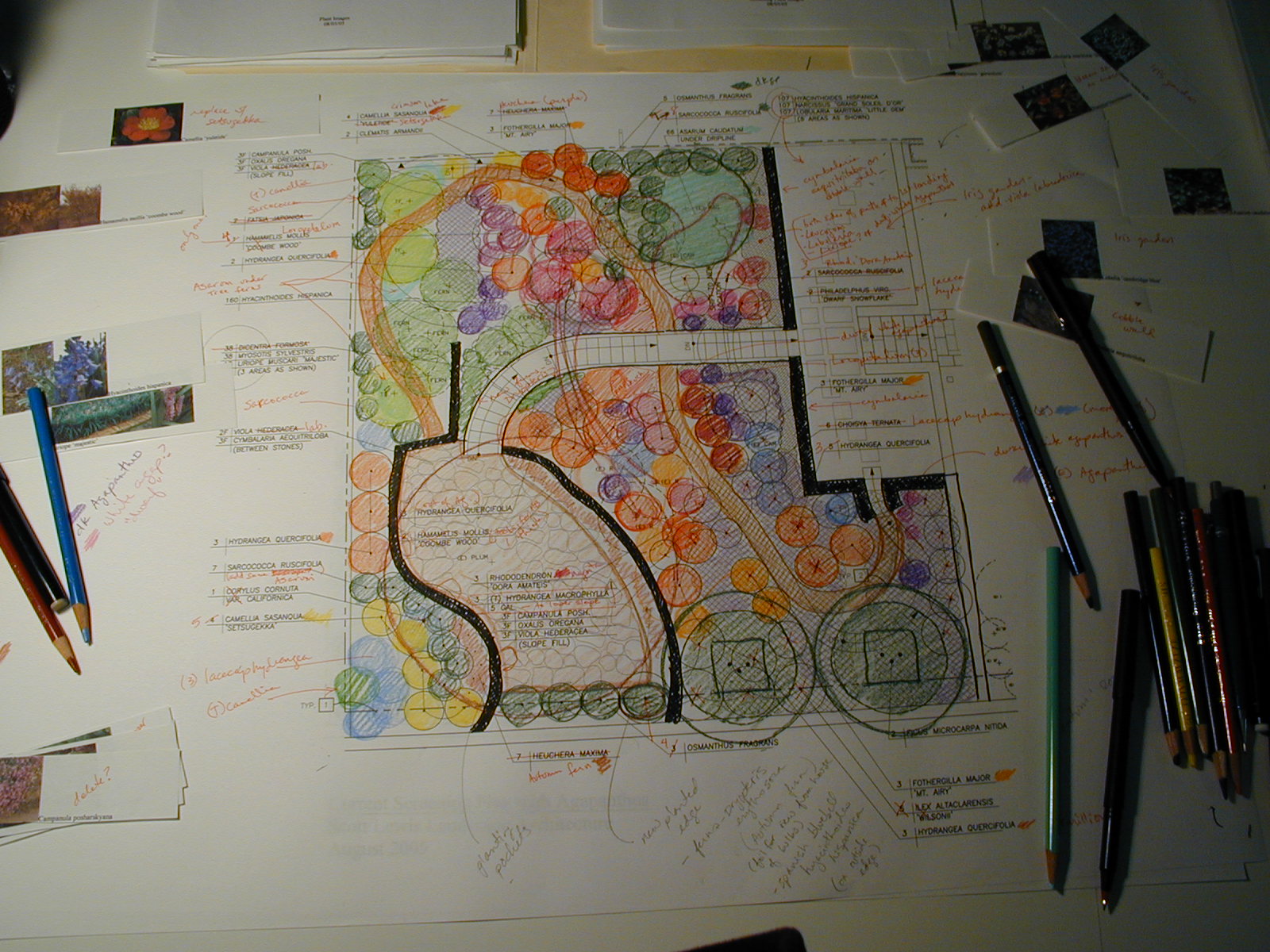 Thanks!
Thanks!
Favorite Projects
About 5 years into my career, I left a job working on a wide variety of projects (hospitals, schools, trail systems, public parks, commercial spaces, but very few private residences) for a job that was exclusively private residences and estate work. I thought at the time that I was "looking for the soul" in Landscape Architecture....
Read more



